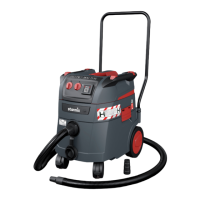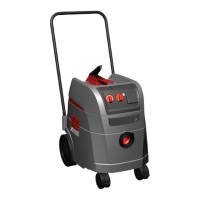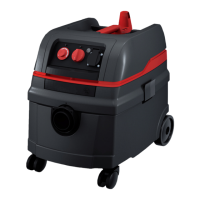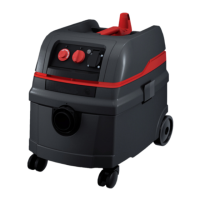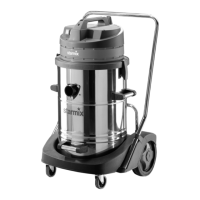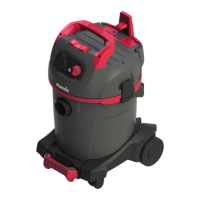28 - en
* depending on model
▶ Insert new folded lter cartridges.
▶ Lift the locking bracket up, fold down the cover and click in place
with light pressure.
9 Changing the motor protection lter
(see Quick Reference Guide ).
NOTE
If motor protection lter is contaminated, this indicates defective
lter cartridges.
▶ Replace folded lter cartridges.
▶ Replace motor protection lter or wash the motor protection
lter under owing water, dry and re-insert.
10 Transport
▶ Remove suction hose.
▶ Close off intake socket with cap.
▶ Securely x the motor head to the container.
▶ Close the side latches.
▶ Place the accessories in a suitable plastic bag and seal the plas-
tic bag or place it in the tool storage compartment.
▶ Put the suction hose ends together so that no dirt particles leak
out.
▶ Place the hose around the vacuum cleaner and clamp onto the
handle (see Quick Reference Guide).
11 Maintenance
NOTE
Switch off the vacuum cleaner and pull out the mains plug before
carrying out any maintenance work.
For maintenance by the user, the vacuum cleaner must be
- dismantled,
- cleaned and
- maintained,
as far as possible without creating any danger to the maintenance
personnel or other.
Precautionary measures
Suitable precautionary measures include:
- Cleaning before dismantling
- Provision of local ltered positive ventilation where the vacuum
cleaner is to be dismantled
- Cleaning of the maintenance area
- Suitable personal protection equipment
Precautionary measures with vacuum cleaners class H and M
The outside of the vacuum cleaner should be cleaned by dust
extraction procedures and wiped down, or should be treated with a
sealing agent before being removed from the hazardous area. All
parts of the vacuum cleaner must be considered to be contaminat
-
ed when they are removed from the hazardous area, and suitable
handling must be used to prevent dust distribution.
Contaminated items
When carrying out maintenance or repair work, all contaminated
items which have not been adequately cleaned, must be disposed
of. Such items must be disposed of in impermeable bags in
accordance with the applicable regulations concerning the disposal
of such waste.
11.1 Testing the effectiveness of the vacuum
cleaner
At least once a year, the manufacturer or an instructed person must
perform a technical inspection including lters, air tightness of the
vacuum cleaner, and control mechanisms.
In addition, the effectiveness of the vacuum cleaners with dust
class H and H-asbestos must be checked at least once a year or
more frequently. The test method, which can be used for demon
-
strating the effectiveness of the device, is dened in EN 60335-2-69
AA.22.201.2. If the test is not passed, it must be repeated with a
new main lter.
There must be an adequate air exchange rate L in the room if the
exhaust air returns to the room. Observe national regulations.
If the suction power of the vacuum cleaner is reduced and the
cleaning of the lter cartridges is no longer sufcient (assuming that
tank is emptied and eece lter bag is replaced), it is necessary to
replace the folded lter cartridges (see Quick Reference Guide
and „8.1 Changing the folded lter cartridges“ on page 27).
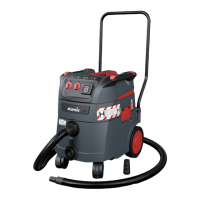
